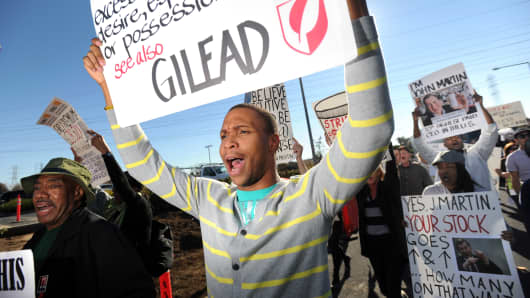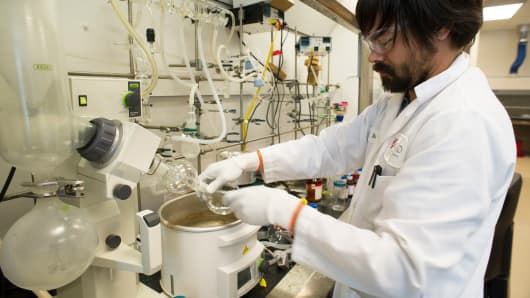The mounting scrutiny of prescription drug prices in the U.S. reached fever pitch when a new drug for hepatitis C was priced at about $1,000 a day.Gilead Sciences' Sovaldi, approved in December, cures the viral liver infection in most cases. it takes about 12 weeks, and costs $84,000.
Health insurers as recently as this week have called the price astronomical and unsustainable. Sovaldi has become the poster child for the outcry over prescription drug prices: In March, Congress sent a letter to Gilead asking it to explain how it set Sovaldi's price, contributing to a swoon in biotech stocks over the following month as investors worried pricing may finally come under pressure in the U.S.

AP
About 40 protesters from across the country converged on Gilead Sciences headquarters in Foster City, Calif., Nov. 14, 2012, calling on the drug maker to lower prices for its Stribild AIDS medication.
Sovaldi's not alone. Spending on specialty medicines, for diseases such as cancer, rheumatoid arthritis and multiple sclerosis, helped boost total spending on prescription drugs last year 3.2 percent, to $329.2 billion, according to industry researcher IMS Health. That followed a decline in spending in 2012 as cheaper generic copies of some brand-name drugs hit the market.
Cancer drugs, in particular, have seen prices soar. The average cost of a branded cancer medicine in the U.S. has doubled in the last decade, to about $10,000 a month, IMS said.
The rising prices have concerned some doctors, leading Memorial Sloan-Kettering Cancer Center in 2012 to make a bold move: It refused to prescribe the cancer drug Zaltrap, writing in a New York Times op-ed that the medicine provided no benefit to an older therapy, Avastin, yet cost twice as much. The maker of the drug, French pharma company Sanofi, subsequently halved the price.
Last year, more than 100 physicians signed on to an editorial in the journalBlood calling for lower prices on medicines for chronic myeloid leukemia. The blood cancer has seen some of the most striking advances in medicine with the use of Novartis' drug Gleevec and other therapies that followed. Patients with CML can now expect to live almost normal life spans, wrote the authors, led by Hagop Kantarjian of MD Anderson Cancer Center.
The problem: Gleevec was priced at about $30,000 when it was approved in 2001, and its cost more than tripled to about $92,000 in 2012. That's lower than other drugs on the market for the disease, like Novartis' Tasigna, at $115,500, and Bristol-Myers Squibb's Sprycel, at $123,500, the authors wrote. The costs, they say, are unsustainable.
Novartis said the majority of patients pay less than $100 out of pocket each month for its CML treatments. Yet doctors argue despite insurance coverage and co-pay assistance, specialty drugs can still be expensive for patients.
"Access really is a problem for a lot of patients in relation to these very costly medicines," said Jerry Avorn, a professor at Harvard Medical School and chief of the Division of Pharmacoepidemiology and Pharmacoeconomics at Brigham and Women's Hospital. "We sometimes think, 'Well, people have insurance, and under Obamacare there's a lot more coverage,' but what that doesn't take into account is that very often there is a very big co-payment that the patient has to come up with that is often many, many hundreds or thousands of dollars."
The American Society of Clinical Oncology, whose annual meeting is in Chicago next week, has started a task force to consider how much value cancer treatments bring patients, aiming to differentiate between those that add just a few weeks or months of survival and have severe side effects and medicines that provide much more substantial benefits.
"It's really the value of the treatment that we're interested in," Lowell Schnipper, chairman of the society's task force and chief of hematology and oncology at Beth Israel Deaconess Medical Center, said in an interview. "By no means is it the focus on cost."
Value vs. price
That balance between value and price is cited frequently by Gilead in its defense of Sovaldi's $84,000 price tag.
"Sovaldi reduces total treatment costs for HCV—taking into account the cost of medications (including those for side effects or complications) and health-care visits—and it represents a finite cure, an important point to consider when comparing the price of a pill or bottle to the lifetime costs of treating a chronic disease," Gilead spokeswoman Cara Miller said in an email.
Some doctors agree.

David Paul Morris | Bloomberg | Getty Images
A researcher works on a hepatitis C virus drug at Gilead Sciences lab in Foster City, Calif.
"I don't think there's any question that treating patients with hepatitis C will lower overall health-care costs in the coming 20 years," Dr. Douglas Dieterich, a liver disease specialist at Mount Sinai Hospital, said in an interview. He has consulted for pharmaceutical companies including Gilead. "If we could get rid of the liver disease in these patients with hepatitis C, prevent them from dying of liver cancer, cirrhosis and liver failure, then there's no question the cost will be less."
Read MoreObamacare monopoly would be sad: CEO
A liver transplant can cost upwards of $200,000, Dieterich said. Patients must then take immunosuppressive drugs that can cost $40,000 a year for the rest of their lives. The price of Sovaldi, then, looks like a bargain.
Perhaps not so much when compared to what other countries pay. In the U.K., the price is about $57,000, while in Germany, it's about $66,000. In Egypt, Gilead said it will charge about $900.
US pays more
Why are U.S. prices so much higher? For one, governments in other countries negotiate drug prices, something Medicare, the U.S. insurance plan for the elderly and disabled, is prohibited by law from doing. For another, it's still politically untenable in the U.S. to push back on drug prices, said Mark Schoenebaum, an analyst with ISI Group.
"In America we're not yet ready to say no," Schoenebaum said in an interview. "The Brits, with a system called the NICE system, National Institute for Clinical Excellence, they will just say no, you can't have that cancer drug, it's too expensive. We don't do that in the U.S. So if you have a monopoly system, the system allows you to charge whatever you want."
Will that change at any point soon? It's been debated for years. But, Schoenebaum points out, it's widely believed that pharmaceutical and biotech companies agreed to support the Affordable Care Act (aka Obamacare) in exchange for guarantees that the law wouldn't allow the U.S. government to negotiate or set drug prices.
So if the government is unlikely to step in at any point soon, could competition weigh on prices instead?
That's an especially important question in hepatitis C, as Gilead will face competition from Bristol-Myers, Merck and others in the coming years as their drug regimens reach the market. Traditionally, though, increased competition hasn't necessarily weighed on prices: Gleevec continued its ascent even as other drugs in the class, called tyrosine-kinase inhibitors, entered the market.
Insurers and pharmacy benefits managers, though, have signaled they'll use the competing hepatitis C drugs as leverage. Their urge to do so may have become even more acute after Gilead reported first-quarter sales of $2.27 billion, burying analysts' estimates and setting a record for the fastest launch of a drug in history.
—By CNBC's Meg Tirrell.
No comments:
Post a Comment